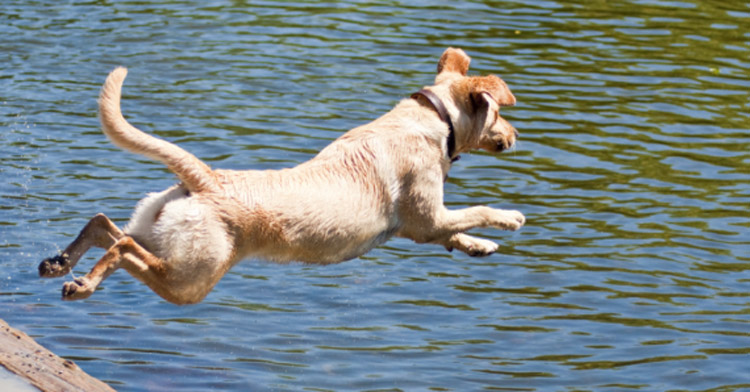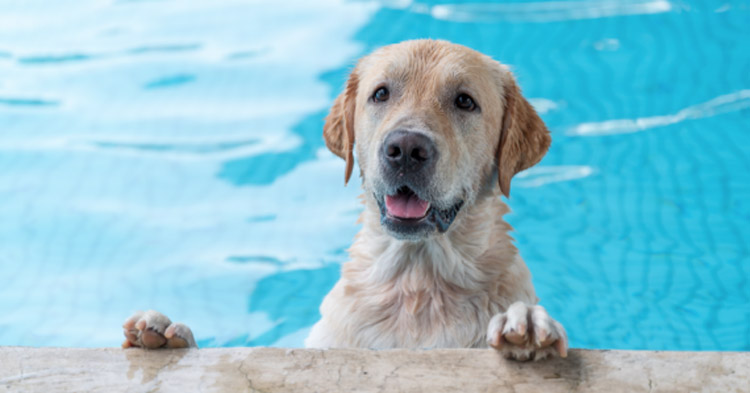- Lifestyle
- 2023
Do all dogs know how to swim?
We can tell you which are the best and the poorest swimmers and give you some advice on helping your dog to swim better.
Not all dogs naturally know how to swim, although it is a very widespread myth. It’s true that their survival instinct means that, if necessary, they try to keep afloat and get about in the water by moving their paws. It’s the same as when we humans learn to swim and our first attempt is ‘doggy paddle’.
The success of some dogs and others at swimming depends on their breed or genetics, anatomy, age and state of health or physical condition. If your dog isn’t doing very well, you can help him to manage better in the water, so we are going to give you a few hints.
The best swimmers
The breeds that most enjoy themselves in the water are the Newfoundland, Golden retriever and Labrador retriever. They also have webbed feet, which means that they have a membrane between their toes that they can use like flippers. This is their secret in achieving stability in movement and better power in swimming. The Golden retriever also uses its tail as a rudder.
Among all of them, the Newfoundland is without doubt the best swimmer. In fact, this is the breed chosen for surface water rescue tasks, particularly in Canada and the United States, where there are specialised trainers. Besides being intelligent, this breed is very strong and capable of pulling a person weighing up to 70 kilos.
Other smaller breeds, such as the poodle and the water dog, have a balanced body, not too fat and not very heavy-boned. This means that they can move their neck and legs easily. And their curly coats are so thick that the water doesn’t even touch the skin. Combined with their love of play, this makes them fanatical about getting into the water.

The poorer swimmers
In contrast, dachshunds or sausage dogs, corgis and basset hounds, with short legs and long bodies, are not very agile swimmers due to their long bodies and their weight distribution. Swimming requires them to make a tremendous physical effort.
Those which find most difficulties in the water are the flat-faced breeds, the bulldog, boxer, Chow chow and pug, because they find it hard to breathe while swimming. Also, greyhounds and gazehounds because their shape, which makes them such splendid runners, makes it almost impossible for them to float. And it’s even worse for the Afghan and other long-haired breeds such as the bobtail, because their fur makes the movements difficult for them. Shih Tzu, Maltese Bichon and Pomeranian in principle float better, although they have little resistance and their short legs do not guarantee their survival if they are in the water for a long time.
And if they're afraid of water?
At the beach, there are often dogs that are scared by the waves. In rivers, while some dogs adore leaping about on the stones and getting wet, others are frightened. In the end, dogs get accustomed to it and although some of them never find it easy, at least they do lose their fear. If not, to the point that you think your dog has a phobia about water, it’s likely that he has been traumatised through having fallen in, probably when he was out of puppyhood, and having experienced the feeling of drowning.

How you can help
Swimming is, as well as excellent physical exercise, an entertaining and cooling activity for your dog. For this reason, it’s a good idea to get him accustomed to being in contact with water as a puppy, provided that it is possible. Knowing how to move about freely in water will also ensure his safety during the summer.
Ideally the learning is gradual, just as it is for humans, so that even as a puppy he learns to move about like a fish in water.
Of course, you can make it more attractive and amusing if you play games, throwing a flying disc or a ball to him.
Even in the case that he’s a good swimmer, never throw your dog into the water. Let him take the decision to go in. If he’s afraid, don’t compel him to go in.
At the beach, try offering him fresh water to drink before bathing, to avoid his drinking seawater.
Avoid risks with a swimming pool, particularly if it is a private pool, is unfenced and the dog is alone in the garden. If the walls of the pool are vertical and it is not absolutely full to the brim, the dog will find it difficult to get out. Here, also, the water being without movement, in contrast to rivers and beaches, makes it even more difficult.
After bathing, damp him down with fresh water to wash off the salt or chlorine, where necessary, and dry his ears with special care. They are a very sensitive area and require much attention.